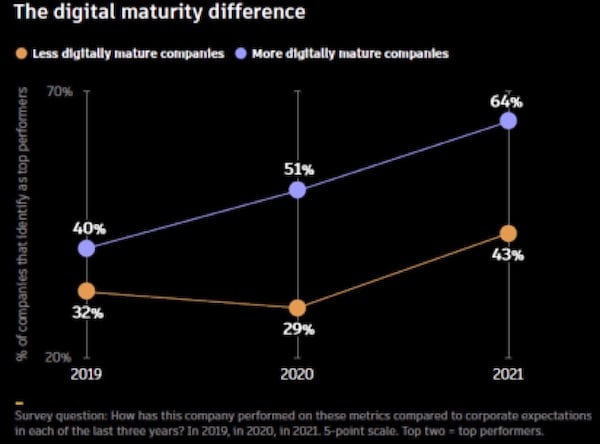The term “digital transformation” might seem daunting to those who have not explored the concept. It might conjure up visions of arduous, expensive, and unpopular changes in workflows, equipment, and personnel. In reality, digital transformation does not have to be painful, and in fact, can produce dramatic improvements in productivity, quality, profitability, and morale. To realize these improvements, organizations need to identify the areas where digital transformation can offer benefits and implement it wisely.
While definitions of digital transformation vary, a good starting point is to consider it the process of integrating digital technologies to improve business outcomes. It may involve replacing manual processes with more automated, digital processes. It may encompass various types of IT modernization — hardware, software, products, and services — anything that makes an organization more techsavvy. The exact form can vary by industry or company.
Some common threads emerge when considering digital transformation. For starters, organizations should recognize that people are their greatest assets. Even with cutting-edge technology, a company can languish if people are not properly engaged.

Image source: photon_photo/stock.adobe.com.
When digital technology helps people become more productive, organizations and individuals both benefit.
And as with most business decisions, a holistic solution is typically more effective than a piecemeal solution. No single software product will instantly enable a company to complete a digital transformation. More likely it’s a combination of hardware, software, human resources, and cultural changes that lead to a digital transformation.
A 2023 State of Design & Make report prepared by Autodesk and research partner Ipsos identified some common characteristics of digital transformation. As part of the report, the team surveyed and interviewed 2,565 experts in various industries, including architecture, engineering, construction, and owners (AECO); design and manufacturing (D&M); and media and entertainment (M&E). Here are some key findings that applied to multiple industries:
- 79% said the future growth of their company will depend on digital tools.
- 72% said the workforce has evolved more in the past three years than it had in the previous 25 years.
- 64% of top performing companies were determined to be “more digitally mature” companies.
- 80% said improving sustainability practices is a good long-term business decision.
- 48% cited attracting and retaining talent as a top challenge for their companies, more than any other factor.

A survey by Autodesk and Ipsos found that more digitally mature companies outperformed those that are less digitally mature, and the performance gap appears to be growing over time. Image source: Autodesk.
Benefits to Digital Transformation
With common threads to digital transformation identified, most business leaders will want to know what benefits to expect — tangible business outcomes that make digital transformation a worthwhile investment. Potential benefits are numerous, but can be grouped into three main categories: improved efficiency, increased profitability, and improved quality.
Improved efficiency is often a holy grail for companies large and small. Most firms continually seek to improve efficiency, but may struggle with how to achieve and measure efficiency gains. Digital tools can help address these challenges. In a manufacturing environment, a digital manufacturing executing system (MES) can help firms monitor product development, from design through manufacturing and testing, addressing common pain points and streamlining processes. Instead of relying on paper-based documents (a.k.a., travelers) to monitor processes, digital tools can provide more real-time information on products, workflows, supply chains, schedules, and other data — often accessible via mobile devices.
For AECO firms, digital tools can help eliminate silos, where designers of different disciplines work independently and often duplicate efforts, rather than sharing data seamlessly throughout project lifecycles. Instead of spending time developing and compiling disparate paper-based construction plans, designers can develop digital models of projects that are more readily updated and distributed to project participants.
Along with improved efficiency, digital tools can lead to increased profitability. Projects completed with fewer person-hours can directly benefit the bottom line. And contrary to fears of some workers, this does not necessarily mean elimination of jobs. With many industries struggling to find and retain qualified workers, automation and other digital tools can help the same number of people perform more work and introduce innovative methods into workflows, enabling companies to pursue and complete
more projects.
Digital technology can also enhance profit margins by helping teams identify potential problems earlier in the process. For example, 3D modeling and building information modeling (BIM) tools can help identify spatial conflicts between structural and mechanical systems during design, rather than during construction, when rework is often more expensive and time-consuming. Reduction of rework can help designers, builders, and owners become more profitable.
In manufacturing settings, digital technology can help automate manual processes and reduce waste, to improve bottom lines. WireCrafters, a producer of wire partition products, achieved significant time savings through digital transformation. “WireCrafters was experiencing challenges with our existing sales configurator,” stated Aaron Eubank, national sales manager at WireCrafters. “It was not web-based and did not communicate with our ERP system. This led to issues with non-compatible part numbers, duplicate work by having to re-enter data and reporting issues.”
WireCrafters approached IMAGINiT for assistance in digitally transforming manual processes to improve quality and efficiency in generating quotes. IMAGINiT proposed automation that leveraged Autodesk Factory Design to create an online, custom library of parts that sales and engineering staff could access for their designs. With an electronic, automated sales configurator, sales staff can now pass approved quotes to the engineering team, who then creates a 3D model with cloud-based part information for client approval and detailed cut sheets for engineering. This new digital process allowed WireCrafters to reduce by 40% the time spent creating, getting customer approval of, and relaying design specifications to engineering. Find out more about WireCrafters and how using custom software helped them automate processes and reduce design time.
Quality can also benefit from digital technology. In addition to the previous example of avoiding spatial conflicts, digital tools can help companies standardize processes and avoid “reinventing the wheel” on individual projects. More consistent data standards can be implemented and monitored, enabling a culture of continuous improvement.
What’s Next?
If your organization is contemplating a digital transformation, you should work with a qualified solutions provider, such as IMAGINiT, to develop and implement a plan. Working with your provider, you can review which aspects of digital transformation might be of most interest to your organization. In future articles, we will explore the technologies that enable digital transformation and the paths to success when implementing your own digital transformation initiatives.
ARTICLE SPONSORED BY IMAGINiT Technologies.






Share This Post